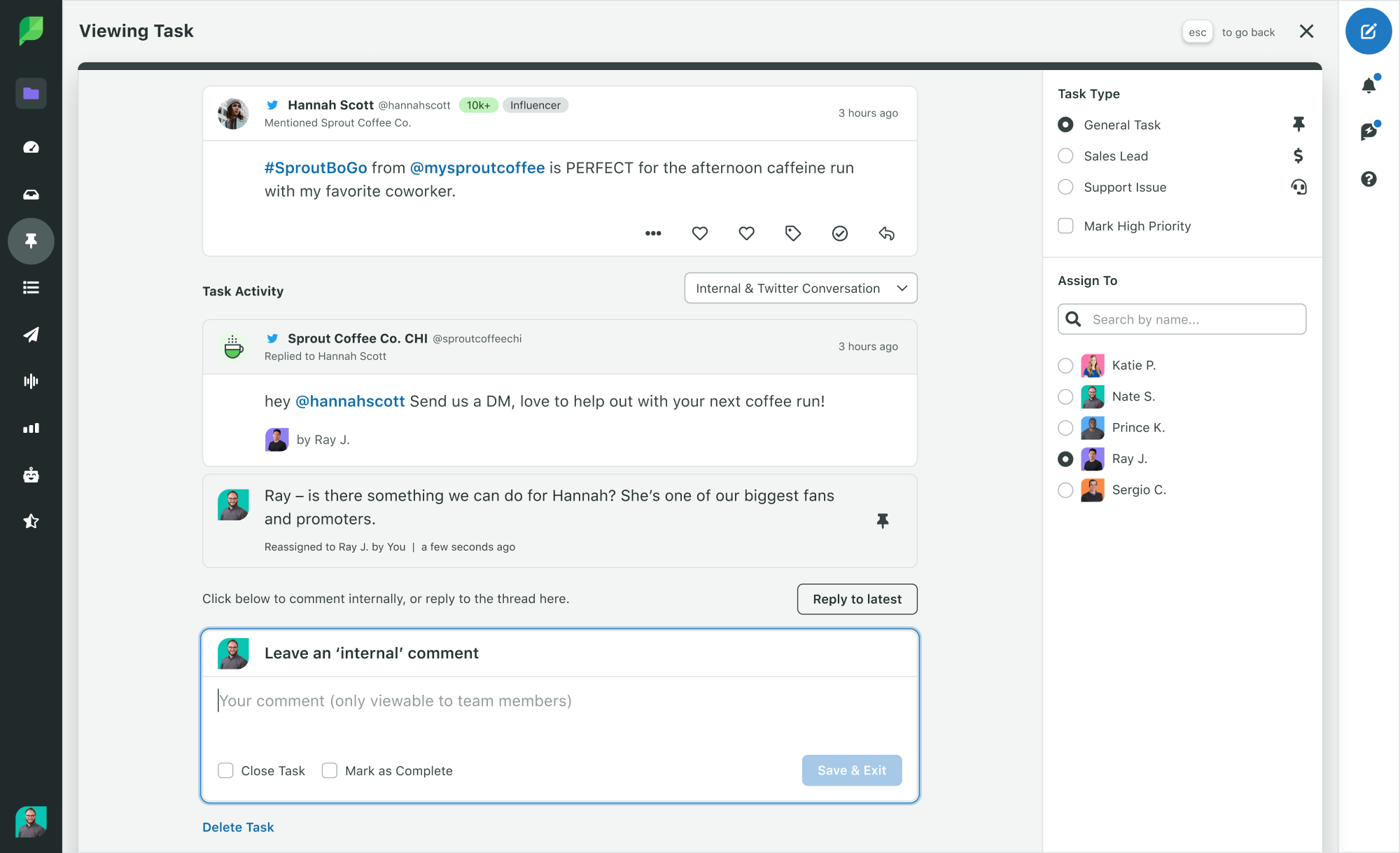Sprout Social for Agencies
From multi-client social management for digital marketing shops to enterprise-level interagency teams, Sprout Social makes it simple and efficient to centralize agency social efforts on one powerful platform.
As mentioned at the beginning of this guide, today’s social agency landscape is as varied as the brands and client engagements they represent. From traditional PR and integrated digital groups to dedicated content production or community management teams, agencies of all types are brought on to handle a multitude of responsibilities within a business’ social program.
Whether providing full service social solutions or stepping in for a specific campaign or project, agencies understand how to deliver results. And within a sole social agency, each client engagement can call for a distinct set up—whether that’s one-to-many, many-to-one or collaborative.

When agency teams need tools to implement these social initiatives for their clients, they use Sprout Social. With Sprout’s publishing, engagement and reporting tool sets, agencies can utilize one or combine all to meet their needs. In addition, as client portfolios grow and objectives change, Sprout’s flexible account structure and custom permissions make scalable client management a reality.
Let us show you the different ways Sprout can accommodate your agency’s working style.
Getting Set Up in Sprout
Getting your agency up and running in Sprout is quick and easy. It’s important to set parameters from the beginning so everyone understands their roles and responsibilities, and how they work together as a unit.
If you haven’t used Sprout before or don’t currently have an account, you can get started with a free trial to experience the workflows yourself!
To connect a social profile:
- Click
 in the upper-right corner. You can also connect a profile by clicking
in the upper-right corner. You can also connect a profile by clicking  > Settings > Users & Social Profiles and selecting + connect social profiles above the Your Company column.
> Settings > Users & Social Profiles and selecting + connect social profiles above the Your Company column. - Select the Group that the profile will belong to from the In Group dropdown.
- Select the network you’d like to add. There may be additional options to select based on the network you chose.
- Click the button in the lower right corner of the Connect a Profile screen.
- You will be sent to the corresponding network’s site. Follow the prompts to authorize the profile.
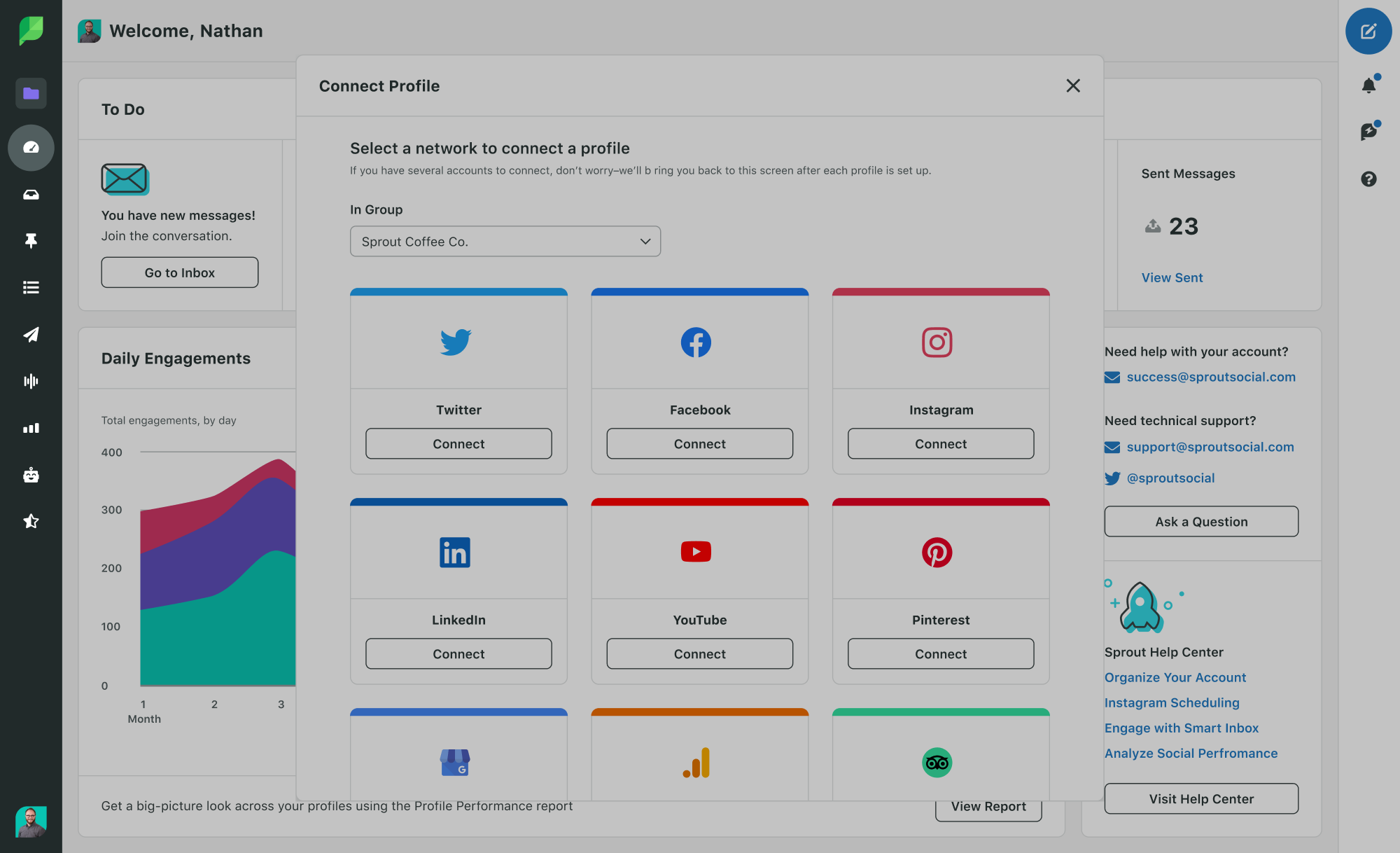
To add social representatives:
Invite a New Team Member
1. Click on the  icon in the upper right hand corner of the application. You can also invite a user by clicking
icon in the upper right hand corner of the application. You can also invite a user by clicking  > Settings > Users & Social Profiles and selecting + invite new team members above the Your Company column.
> Settings > Users & Social Profiles and selecting + invite new team members above the Your Company column.
2. Add the name and email address of the user you wish to invite. Click  to add multiple users.
to add multiple users.
3. Choose the Group(s) and profile access for the user(s). Upon clicking Send Invites, the user(s) will receive an invite email notification.
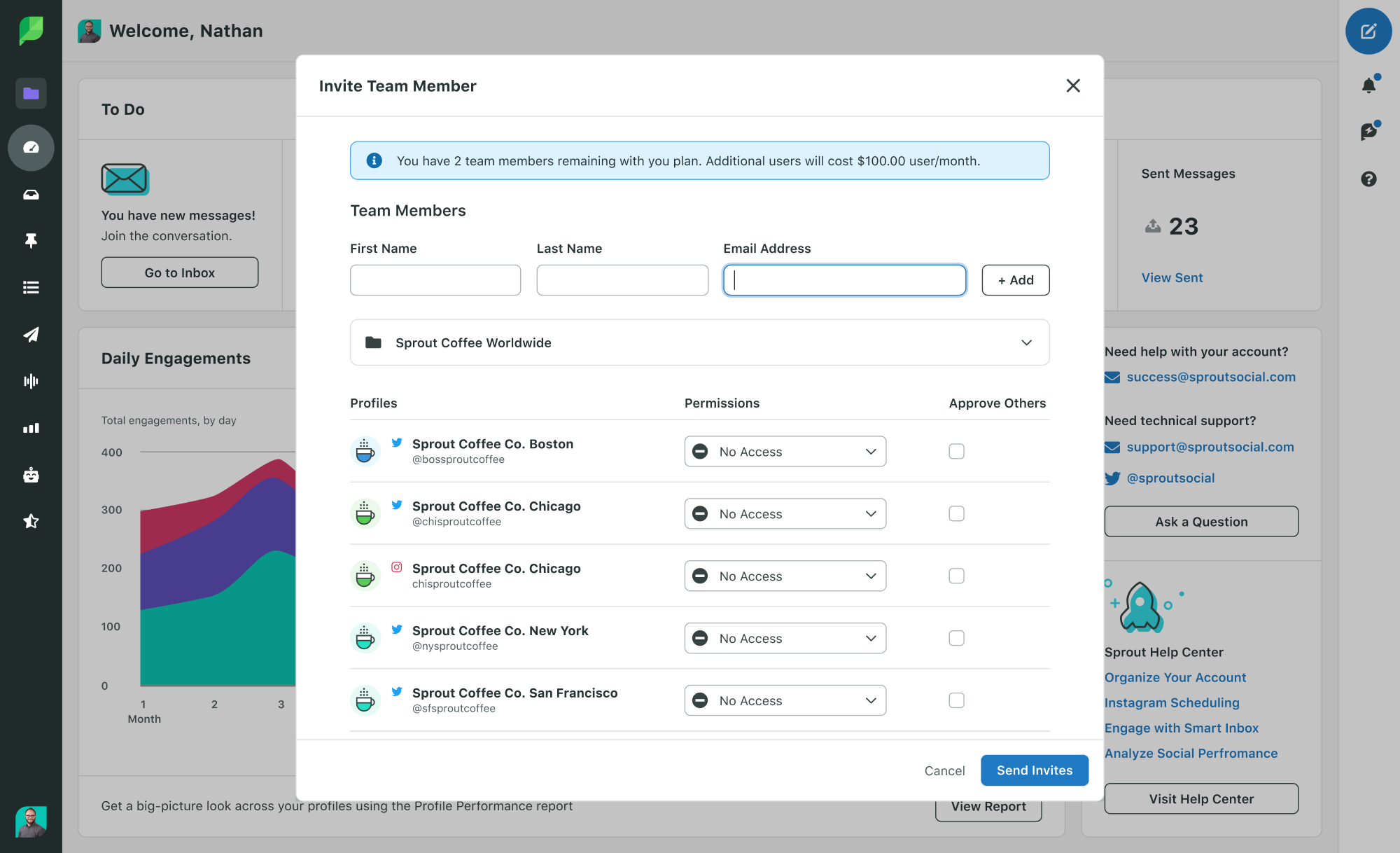
Groups
You can grant team members and client-side contacts access to specific profiles, depending on their responsibilities, then organize those profiles into Groups. Using the flexible Group structure to set up separate, secure client environments makes managing a large client portfolio in Sprout safe and easy. Groups ensure publishing security and align individual users to applicable reporting insights.

Create a Group
1. There are a couple of ways to create a new Group. To use the first method, click the name of the current Group to reveal the Group dropdown. Select + Add Group at the very bottom of the dropdown to create a new Group.

2. Use the second method by first navigating to Settings » Users & Social Profiles, then click +create new group.
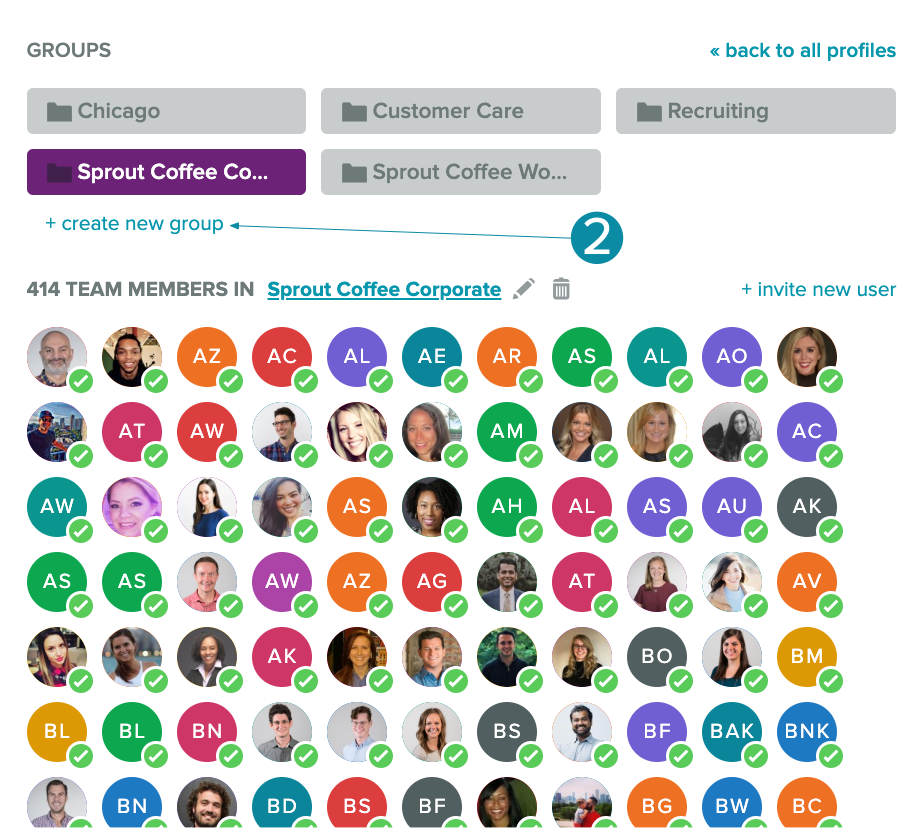
3. After using one of the methods above, choose to either create a new Group associated with a newly added social profile or create a Group from an existing social profile in Sprout.
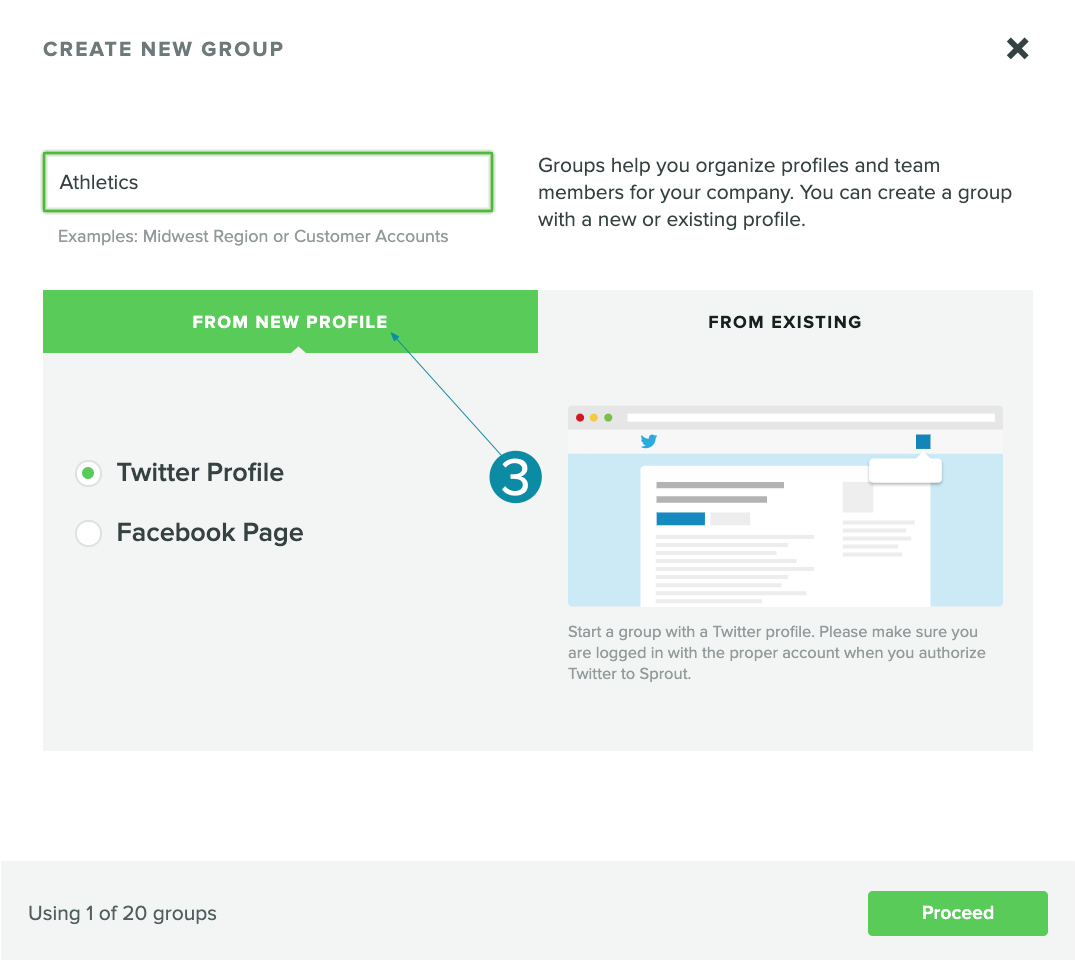
User Settings & Permissions
Setting permissions at the user level ensures the right person is handling the right message and assets. You have two opportunities to configure permissions: when inviting a new user or by going to individual settings screens for Users & Social Profiles and Asset Library. You can configure permissions based on publishing, reporting and administrative access to align with your agency’s and client’s responsibilities.

Agency Use Case 1: Full-Service Solutions
- Agency type: Full service social media marketing
- Client engagement: One-to-many
- Agency set up: A mid-sized agency with a client portfolio of local and regional brands works in teams of social strategists and Community Managers. Each Community Manager is responsible for fully managing social programs on behalf of four client brands each.
- How Sprout powers the agency: Managing social media for all your clients is easy using Sprout. Your team can publish, engage and analyze all from one platform.
To get the most out of published content, Community Managers use the Scheduler to publish time-sensitive messages at a specific time; or use ViralPost to ensure your client’s audience sees content at the optimal time for engagement.
Monitor and engage with incoming messages across all client profiles and networks using the Smart Inbox. Filter the inbox to concentrate on certain profiles, networks or message types, and mark messages as complete as you work towards inbox zero.
The mobile apps enable each Community Manager to stay connected even while on the go; team members can publish and engage right from their phone.
Use Case 2: Campaign Solutions
- Agency type: Campaign marketing / Campaign management
- Client engagement: Many-to-one
- Agency set up: A large global agency with a client portfolio of international brands works in teams that are responsible for managing social campaigns on behalf of each client.
- How Sprout powers the agency: Social-driven campaigns are, by nature, high-touch from strategic planning through execution. Sprout enables teams to gather strategic insights during the planning phase, manage customer engagements during execution and analyze results post-campaign.
Before your team starts ideation for a client campaign, the analyst uses the Twitter Listening Report to measure keyword volume in order to inform the campaign’s hashtag and creative strategy. Client approvals are streamlined using the Message Approval workflow, where stakeholders can approve or reject with feedback.
When executing the campaign, the team uses the Asset Library, Message Tagging and Content Calendar to plan and organize outgoing social posts. Throughout the lifecycle of the campaign, the team also uses Message Tagging to categorize incoming messages, like those using the dedicated hashtag.
Once the campaign wraps, the analyst uses the Tag Report to track volume, determine sentiment and analyze overall campaign performance to report back to the client.
Use Case 3: Content Strategy Solutions
- Agency type: Content marketing
- Client engagement: Collaborative
- Agency set up: An agency with a client portfolio of national brands appoints a content marketing team to each client project. Each content team is responsible for planning, creating and executing content marketing strategies on behalf of each client.
- How Sprout powers the agency: Content, context and audience are the keys to a successful content strategy.. Sprout’s publishing toolset enables agency teams to create and publish content tailored to specific platforms and audiences.
As your content team starts to create content, they use Compose to draft messages, including imagery from the Asset Library, then apply audience targeting to ensure the client’s messages reach the right audience.
Client approvals are streamlined using the Message Approval workflow, where stakeholders can approve or reject with feedback. Once the messages are approved and scheduled, the team can identify publishing gaps using the Content Calendar, and repeat the process to fill those holes.
The Sent Messages Report enables the team to analyze the content’s performance and adjust the content strategy as needed. Export the report to PDF for a presentation-ready version for your client or select the CSV file to further analyze specific KPIs and data points.
Use Case 4: Community Management Solutions
- Agency type: Community management and engagement
- Client engagement: One-to-many/Collaborative
- Agency set up: A niche agency that focuses on multi-location businesses manages a portfolio of 25 franchise brands which maintain hundreds of local, regional and national social profiles. Each project team is responsible for managing customer care on behalf of the client’s entire portfolio of social properties.
- How Sprout powers the agency: Reactive communication and customer care is vital to building and maintaining social relationships. Agencies use Sprout’s engagement toolset to discover, manage and address incoming messages on behalf of their clients.
The Smart Inbox is where your account team will monitor and engage with incoming messages across profiles and networks. Set up Brand Keywords so Community Managers can find and engage in conversations that are important to its client—such as campaign hashtags, location check-ins or even competitor names—but may not include direct mentions.
As messages stream into the inbox, Community Managers collaborate with each other or with the client by assigning messages as Tasks to ensure the right person is responding to the message. Community Managers Mark messages as complete as the account team works toward inbox zero.
Analysts use the Engagement Report to track response rates and times to meet the client’s engagement KPIs, as well as report on those efforts.
Use Case 5: Analytics Solutions
- Agency type: Social analytics
- Client engagement: Many-to-one
- Agency set up: An agency with a client portfolio of national brands appoints one team of analysts per client account, which is responsible for setting and analyzing social strategy on behalf of each client.
- How Sprout powers the agency: If your agency drives social strategy and execution for your clients, you need data to enforce its effectiveness. Sprout’s suite of reports enables your agency to prove its worth and use insights to tweak your strategy.
The Group Report is a high-level overview that provides aggregate data across social networks so your client has a better understanding of social efforts as a whole.
Pair the Group Report with the network profile reports—Twitter Profiles, Facebook Pages, Instagram Profiles and LinkedIn Company Pages—for an in-depth look at specific social channels. Use these reports to demonstrate growth and audience behaviors across all channels and profiles.
Export the reports to PDF for a presentation-ready version for your client or select the CSV file to further analyze specific KPIs and data points.
Use Case 6: Customer Service Solutions
- Agency type: Customer service
- Client engagement: One-to-many
- Agency set up: A mid-sized customer service agency with a client portfolio of national brands appoints Customer Advocate teams to manage customer care around the clock for each client.
- How Sprout powers the agency: Creating a wonderful customer experience is important for agencies focusing on customer service. Sprout’s customer service toolset enables you to execute and analyze your efforts.
The Smart Inbox is where advocacy teams monitor and engage with incoming messages across profiles and networks. As messages stream into the inbox, the Customer Advocate Lead collaborates with the Customer Advocates or the client by assigning messages as Tasks to ensure the right person is responding to the message.
Account Directors use the Task Performance Report to analyze Tasks usage and completion between teams and advocates. Account Directors use the Team Report in conjunction to track their team’s social performance with reply metrics by individual, across all profiles and across specific profiles.
Export the reports to PDF for a presentation-ready version for your client or select the CSV file to further analyze specific KPIs and data points.
The Solution for Agencies
In today’s world, social campaigns and client engagements vary greatly; Sprout thrives in all types of agency environments. Agencies use Sprout to work on behalf of—and collaborate with—their clients. Sprout enables agencies and teams to plan and publish campaigns, manage social communities and conversations, and measure performance to demonstrate real results so they can win new business.

